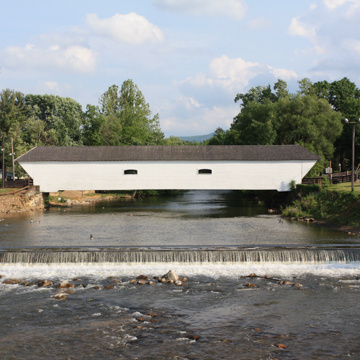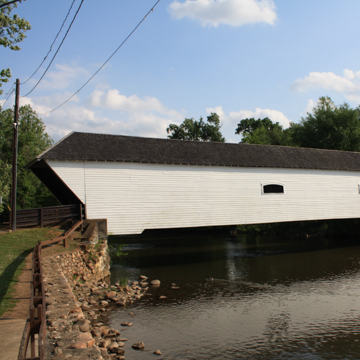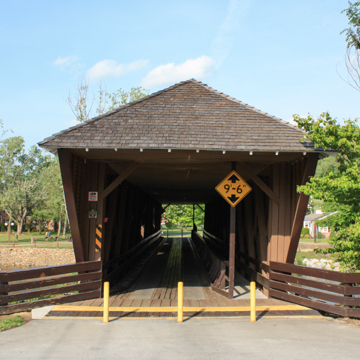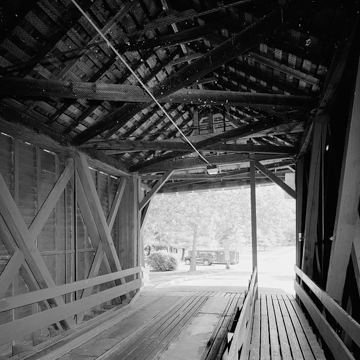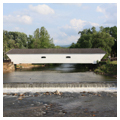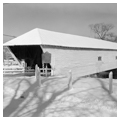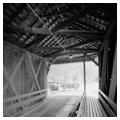You are here
Doe River Covered Bridge
The Doe River Covered Bridge is one of only three historic covered bridges remaining in Tennessee and one of the few in the United States to survive in an urban setting. Located in downtown Elizabethton, near the Public Square, the bridge was constructed in 1882 and is a well-preserved and excellent example of a timber-trussed bridge with a hip roof resembling covered bridges in central Europe.
Founded in 1797 as the county seat of Carter County in upper East Tennessee, Elizabethton was platted on the east bank of the Doe River near its confluence with the Watauga River. In the late nineteenth century, topography and frequent flooding forced the town to grow westward. In April 1882 the county court approved expenditures totaling $3,300 to build a bridge and approaches in order to span the Doe River, connecting Hattie Avenue and 3rd Street. General contractor Dr. Edwin Eugene Hunter (1845–1918) oversaw construction by a crew of local carpenters, which lasted from the summer of 1882 to early 1884.
To design the bridge, the county hired local civil engineer Colonel Thomas Edmund Matson (1847–1921). A Baltimore native who had worked in New York City and Philadelphia, Matson was a civil engineer employed by the East Tennessee and Western North Carolina Railroad, a narrow gauge railroad chartered in 1866 to connect iron mines in Cranberry, North Carolina, with Johnson City, Tennessee. Beginning in 1879, Matson designed and supervised construction of the 34-mile long railroad through the difficult terrain of the Appalachian Mountains. Affectionately known to locals as the Tweetsie Railroad, the railway operated through Elizabethton from 1881 to 1950. In 1882, Matson designed two covered railroad bridges near Hampton, Tennessee. Several metal truss railroad bridges designed by Matson still stand in rural Carter County. Matson also worked as a mining engineer for the Cranberry iron ore mines in North Carolina. Once the railroad was completed, Matson relocated to Johnson City where he became an industrialist and served as mayor in 1892–1894. His 1899 home on Boone Street still stands.
The 154-foot-long Doe River Covered Bridge contains a single-span wooden Howe Truss, patented by William Howe (1803–1852) in 1840, that measures 137 feet in length and 16 feet in height. Originally designed for two-way traffic, the bridge has a curb-to-curb width of 16.4 feet and an out-to-out width of 20.4 feet. The abutments are constructed of mortared limestone and masonry. The end portals angle forward about six feet over the approaches. Originally, the oak floorboards were fastened with iron railroad spikes. The hipped roof is covered with wooden shingles and the exterior is covered with weatherboards. Two arched window openings are located on each side of the bridge. Later, the structure was altered into a single-lane bridge with a flanking, interior pedestrian walkway.
Historians estimate that Tennessee once had about 200 covered bridges, but over time they fell victim to floods, fires, decay, abandonment, or replacement. By the 1940s only a dozen remained. Today only three remain standing in their original locations in Tennessee. The others are the 1875 Harrisburg Covered Bridge (1975) in rural Sevier County, which is still open to vehicular traffic, and the 1923 Bible Covered Bridge in rural Greene County, which is a pedestrian bridge.
Surviving several floods and maintained by the City of Elizabethton since 1926, the Doe River Covered Bridge has served as the focal point of a local community festival since 1966. It was listed in the National Register of Historic Places in 1973 as a contributing structure within the Elizabethton Historic District. Three decades later, the National Park Service determined that the Doe River crossing is one of 20 covered bridges in the United States eligible for consideration as a National Historic Landmark. The Federal Highway Administration and the Tennessee Department of Transportation funded a $400,000 bridge rehabilitation in 2003–2004. At that time, it was closed to vehicular traffic and converted into a pedestrian-only bridge and it remains a popular destination in Elizabethton. In 2006–2009, the HAER photographs were included in the Smithsonian Institution’s Covered Bridges: Spanning the American Landscape multi-city traveling exhibit.
References
Beach, Ursula Smith. “Tennessee's Covered Bridges, Past and Present.” Tennessee Historical Quarterly28 (Spring-Winter 1969) 3-23.
Beasley, Ellen, “Elizabethton Historic District,” Carter County, Tennessee. National Register of Historic Places Registration Form, 1972. National Park Service, U.S. Department of the Interior, Washington, D.C.
Bennett, Lola, “Covered Bridges NHL Context Study.” National Register of Historic Places Multiple Property Documentation Form, 2003, National Park Service, U.S. Department of the Interior, Washington, D.C.
Bennett, Lola, “Doe River Bridge (Elizabethton Bridge), HAER No. TN-41,” Carter County, Tennessee. National Covered Bridges Recording Project, Historic American Engineering Record, Written History, 2003. National Park Service, U.S. Department of the Interior, Washington, D.C.
Boucher, Jack E., “Elizabethton Covered Bridge, HABS No. TN-224,” Carter County, Tennessee. Historic American Buildings Survey, 1965. National Park Service, U.S. Department of the Interior, Washington, D.C.
Carver, Martha. “Tennessee’s Survey Report for Historic Highway Bridges.” Nashville: Tennessee Department of Transportation, 2008.
Lowe, Jet, “Doe River Bridge (Elizabethton Bridge), HAER No. TN-41,” Carter County, Tennessee. National Covered Bridge Recording Project, Historic American Engineering Record, Photographs, 2002. National Park Service, U.S. Department of the Interior, Washington, D.C.
Minsley, Brad. “Tweetsie Railroad.” In Encyclopedia of North Carolina, edited by William S. Powell. Chapel Hill: University of North Carolina Press, 2006.
“Thomas E. Matson.” Tennessee Death Records, 1908–1958.
Waite, John. R. The Blue Ridge Stemwinder: An Illustrated History of the East Tennessee & Western North Carolina Railroad and the Linville River Railway. Johnson City, TN: Overmountain Press, 2003.
Writing Credits
If SAH Archipedia has been useful to you, please consider supporting it.
SAH Archipedia tells the story of the United States through its buildings, landscapes, and cities. This freely available resource empowers the public with authoritative knowledge that deepens their understanding and appreciation of the built environment. But the Society of Architectural Historians, which created SAH Archipedia with University of Virginia Press, needs your support to maintain the high-caliber research, writing, photography, cartography, editing, design, and programming that make SAH Archipedia a trusted online resource available to all who value the history of place, heritage tourism, and learning.

